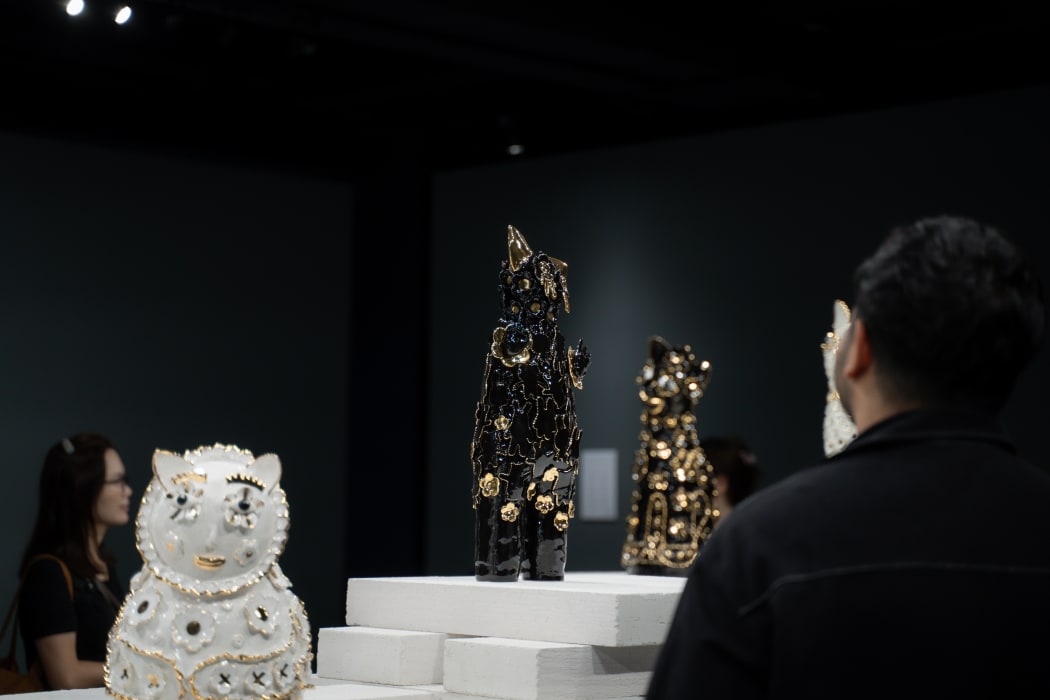OPEN HOURS:
Tuesday - Saturday 11AM - 6PM
Close on Sunday, Monday and Pubilc Holidays
For more information: info@sac.gallery

(English is below)
สีดา, อิเหนา, แก้วหน้าม้า และมัทนา
ข้างต้นคือชื่อของตัวละครจากวรรณคดีไทยเรื่องต่างๆ ที่ วิภู ศรีวิลาศ ศิลปินเซรามิกระดับโลก นำมาสร้างสรรค์เป็นผลงานศิลปะ น่าสนใจว่าตัวละครจากหลายเรื่องมีนัยถึงความเป็นเควียร์ซ่อนอยู่ ซึ่งเป็นประเด็นที่วิภูให้ความสนใจและมักหยิบยกขึ้นมาพูดถึงอยู่บ่อยๆ
รศ.ดร.นัทธนัย ประสานนาม อาจารย์ประจำภาควิชาวรรณคดี รองคณบดีฝ่ายวิจัยและสร้างสรรค์ คณะมนุษยศาสตร์ มหาวิทยาลัยเกษตรศาสตร์ หนึ่งในสปีกเกอร์ของงานเสวนา “Queer Visibility in Thai Visual Culture: Diverse Stories Amplifying LGBTQ+ Narratives” ที่ เอส เอ ซี แกลเลอรี (SAC Gallery) เมื่อวันที่ 2 มีนาคม 2024 ยกตัวอย่างผลงานก่อนหน้านี้ของวิภู ในนิทรรศการ “THE TANGIBLE TALES” ที่เขาหยิบยกเรื่องแก้วหน้าม้ามาใช้ เนื้อเรื่องนี้กล่าวว่า แก้วหน้าม้ามีหน้าม้าที่สามารถถอดออกได้ เมื่อมีหน้าม้าทำให้มีอำนาจเหนือผู้ชาย จึงทำให้แก้วหน้าม้าเป็นตัวละครที่มีมิติและมีความซับซ้อนในวรรณคดีไทย และน่าสนใจไม่น้อยเลยทีเดียว
เช่นเดียวกับงานชิ้นล่าสุด ที่เขายกนางวิฬาร์จากเรื่องไชยเชษฐ์มาสร้างเป็นนิทรรศการชุด “วิฬาร์ วิลิศมาหรา: Eleganza Extravaganza Cats” เนื้อความต้นฉบับกล่าวว่า นางวิฬาร์คือแมวปากแจ๋วที่ออกมาถากถางพระเอกอย่างพระไชยเชษฐ์ที่ด้านหน้าประตูเมือง ซึ่งฉากนี้ดุเด็ดถึงขั้นถูกนำมาใช้เป็นการแสดง “แมวเย้ยซุ้ม” นาฏกรรมที่ให้แสงกับนางวิฬาร์ตัวนี้เป็นพิเศษ
“การรำต้องเลียนแบบท่ารำของแมว ที่มีความ sassy แบบแมว เชิด ถากถาง ไม่อยู่ในโอวาทใคร ความน่าสนใจของนางวิฬาร คือ ในเนื้อเรื่องถือว่าเป็นตัวละครรองหรือตัวประกอบก็จริง แต่เป็นตัวประกอบที่ memorable มากพอที่จะจัดให้มีการรำเดี่ยวได้”
ด้วยเหตุนี้อาจารย์นัทธนัยจึงตั้งข้อสังเกตต่อว่า เพราะการแสดงที่มีแมวเป็นตัวเด่นนี่เอง อาจเป็นส่วนหนึ่งที่ทำให้วิภูจำนางวิฬาร์ได้ และนำไปสู่การสร้างงานศิลปะชุดนี้ขึ้นมา
“ไม่ว่าจะแก้วหน้าม้าหรือนางวิฬาร์ก็ดี อยู่ใน Visual Culture ประเภทการแสดง มีนาฏกรรม มีเครื่องทรง มีความเยอะ ซึ่งอาจเชื่อมโยงกับแมวที่เราเห็น เพราะแมวที่เราเห็นนี้ไม่ใช่แมวธรรมดา เช่นมีลักษณะตาเบิกโพลงเป็นทองคำ”
เมื่อกลับจากโลกวรรณคดีมาสู่โลกความเป็นจริง แมวคือสัตว์ที่มีความสามารถพิเศษ จนบางครั้งมีคำกล่าวว่า “แมวมีสถานะเป็นของเหลว“ สามารถปรับเปลี่ยนรูปร่างได้ตามสภาพแวดล้อม ภาชนะ คล้ายกับว่าไม่มีกระดูก ขณะที่คุณลักษณะของแมวที่ไม่อยู่นิ่ง ไม่อยู่ในกรอบ แถมเย่อหยิ่งและเลี้ยงเท่าไรมันก็ไม่เชื่องกับเราสักที จนถูกนิยามว่าเป็นเจ้านายของคนเลี้ยง ส่วนผู้คอยให้อาหารกลับกลายเป็นทาสที่ต้องคอยปรนนิบัติแทน เหล่านี้อาจนำไปเปรียบเทียบกับนิยามความหมายของ “ภาวะเควียร์” ที่หมายถึง เพศวิถีที่ไม่เสถียรและสามารถเป็นอะไรก็ได้ตามที่ต้องการ
“แมวไม่อยู่ในกรอบ แมวเป็นสัตว์เลี้ยงก็จริง แต่หลายครั้งเราก็พบว่าแมวไม่อยู่ในโอวาทของผู้เลี้ยง และในบริบทไทย เราก็พลีกายจนใช้คำว่าทาสแมวในโซเชียลมีเดีย จะเห็นว่าแมวไม่ใช่สิ่งที่ทำให้เชื่องได้ อยู่นอกเส้นตลอดเวลา หรือแม้แต่แมวเป็นของเหลว แมวสามารถลงไปในโหล สามารถผ่านช่องประตูที่แคบได้ แมวเป็นความลื่นไหล เป็นของเหลว ความไม่อยู่ในเส้น แมวอาจมีศักยภาพเป็น queer figure หรือ queer iconได้” อาจารย์นัทธนัยแสดงทัศนะทิ้งท้ายระหว่างแมวกับความเป็นเควียร์ได้อย่างน่าสนใจ
ความเป็นเควียร์ในวรรณคดีไทยและแมวจากงานเสวนาครั้งนี้ น่าจะทำให้เข้าใจแนวคิดการสร้างสรรค์ผลงานของวิภูในนิทรรศการ วิฬาร์ วิลิศมาหรา: Eleganza Extravaganza Cats มากขึ้น หากใครที่ยังไม่ได้มาชม สัปดาห์นี้เป็นสัปดาห์สุดท้ายแล้ว เพราะนิทรรศการมีถึงวันที่ 16 มีนาคม 2024 เท่านั้น
สอบถามข้อมูลเพิ่มเติม ติดต่อ 092-455-6294 (ณัฐรุจา)
Sita, Inao, Kaew Na Ma, and Mattana are names of characters from Thai literature that “Vipoo Srivilasa” used to create his artwork. Interestingly, many characters from these stories have hidden hints of queerness, an issue that Srivilasa is interested in and often brings up.
Assoc. Prof. Dr. Natthanai Prasannam, a lecturer in the Department of Literature and Vice Dean of Research and Creativity at the Faculty of Humanities, Kasetsart University, was one of the speakers at the event “Queer Visibility in Thai Visual Culture: Diverse Stories Amplifying LGBTQ+ Narratives'', which took place on March 2, 2024, on the 1st floor of SAC Gallery.
He highlighted examples of Srivilasa's previous artwork. In the exhibition “THE TANGIBLE TALES”, Srivilasa used Kaew Na Ma (the character from Thai folk tale) to create his artwork. Prasannam said it was observed that Kaew Na Ma’s horse mask could be removed. He elaborated that when she wears the mask, she exerts power over men. Therefore, Prasannam considered Kaew Na Ma to have dimensional and complex character in Thai literature, quite interesting.
In Srivilasa’s latest exhibition, he used “Nang Wilar” from Chaiyachet to create artwork in the exhibition “Eleganza Extravaganza Cats”. The story from the literature describes Nang Wilar as a sharp-tongued cat who emerges to taunt Phra Chaiyachet in front of the city gate. This scene was so intense that it was adapted into a performance, known as the “Wilar Dance”, that highlights the character of Nang Wilar.
“The Wilar dance must imitate the cat’s moves, which are sassy and independent, just like a cat, and not obedient to anyone. An interesting fact about Nang Wilar is that in Thai drama, Nang Wilar is a supporting role, but it is memorable enough to warrant a solo dance.” Prasannam said.
For this reason, Prasannam further observed that because the show features cats as the main characters, it might be part of why Vipoo remembers Nang Wilar and led to the creation of this artwork.
“Whether it’s Kaew Na Ma or Nang Wilar, they both belong to the category of visual culture performances. They involve drama and numerous costumes, which could be associated with Srivilasa’s artworks, as these cats are not ordinary. For example, the cats have sparkling golden eyes.” Prasannam said.
When transitioning from literature to real life, Prasannam describes cats as intelligent creatures, often likened to having a “liquid status”. He explains that cats can change their shape according to the environment and containers, seemingly without bones.
Meanwhile, cats are restless and arrogant, and they are intractable. These cats are defined as the masters of their cat person, while those who provide them food become servants who must cater to their whims. These traits may be compared to the definition of queerness, which refers to an unstable sexual orientation and the ability to be whatever one wants.
“The cat is outside the box. Many times, cats are considered pets but can never be truly tamed. In the Thai context, we sometimes humorously refer to ourselves as ‘cat slaves’ (cat people) on social media. This reflects the understanding that cats cannot be fully controlled. They always remain independent and outside the norms.
Even their physicality reflects this fluidity, as cats can fit into jars and pass through narrow doorways. Cats embody fluidity and defy confinement. Therefore, cats may have the potential to be Queer Figures and Queer Icons.” Prasannam expressed his concluding thoughts about cats and queerness in an interesting manner.
Queerness in Thai literature and cats from this event should help you understand the concept of Srivilasa’s creations in the exhibition “Eleganza Extravaganza Cats”. If you haven't come to see it yet, this week is your last chance, as the exhibition ends on March 16, 2024
For any additional questions or information, feel free to reach out 092-455-6294 (Natruja)
Tuesday - Saturday 11AM - 6PM
Close on Sunday, Monday and Pubilc Holidays
For more information: info@sac.gallery
092-455-6294 (Natruja)
084-695-6592 (Rungsima)
160/3 Sukhumvit 39, Klongton Nuea, Watthana, Bangkok 10110 THAILAND
This website uses cookies
This site uses cookies to help make it more useful to you. Please contact us to find out more about our Cookie Policy.
* denotes required fields
We will process the personal data you have supplied in accordance with our privacy policy (available on request). You can unsubscribe or change your preferences at any time by clicking the link in our emails.